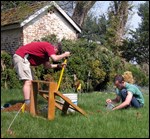|
"Phase I" - Identification of Archeological Resources There are many different types of field methods which archeologists use to identify archeological resources. Some of the methods used at Monocacy include:
But before a method is selected, the researcher must decide what the goal of the survey is, how much time is available, and how large a site is being surveyed. At the Best Farm, for example, the entire farm encompasses over 274 acres - almost 12 million square feet! In order to adequately survey such a large area in an economical and effective manner, the archeology team devised a sampling strategy to ensure that the farm's archeological resources were adequately investigated within the parameters of the project budget. Some of the sampling strategies employed at Monocacy are outlined below. 
Pedestrian Surveys In a pedestrian survey, a team of archeologists walks over a field that has been recently plowed to examine the ground surface for artifacts or archeological features. The area to be examined is divided into sections (often long "lanes" or squares) to provide a controlled way of collecting and managing artifacts. This technique has the advantage of permitting a large area to be surveyed in a short amount of time. One drawback of pedestrian surveys is that the ground surface is not always completely visible, and certain types of artifacts are harder to see. In addition, artifacts on the ground are not always a fool-proof indication of archeological resources, so subsurface excavations are always recommended. 
Shovel Test Pits (STPs) Shovel test pits (STPs) are often used by archeologists to identify where there are artifact concentrations or soil changes, which are often indicative of subsurface archeological materials. An STP is a small hole, slightly wider than a shovel blade, which is placed on a specified interval over the area being investigated. Soil excavated from each STP is screened, artifacts are collected, and field notes are maintained to keep track of soil characteristics and other information. When analyzed, STP data often provide the basis for more in-depth investigations. STP surveys are most effective for investigating small- or medium-sized areas. 
Remote Sensing Remote sensing techniques utilized at Monocacy National Battlefield include systematic metal detecting and gradiometer surveys. Such methods have the advantage of being able to cover large areas in a relatively short amount of time, but they require specialized equipment and operational skills. Systematic metal detector surveys are most effective in areas where metallic materials are expected, which makes them highly effective in battlefield contexts. Systematic metal detector surveys are also effective in locating architectural materials such as nails, hinges, and spikes. However, metal detector surveys are not effective in locating non-metallic objects, such as pottery, glass, or stone.
A gradiometer survey uses a sensitive piece of equipment which measures very small changes in the magnetism of the ground. By mapping these small variations, the researcher may see where areas of organic material, iron material, and earth that has been subjected to fire might be. While this technique may provide a very detailed picture of the sub-surface landscape, it requires a skilled operator to use the equipment and interpret the results.
Backhoe Trenching Backhoe trenching is technique reserved for areas where the top layers of soil are highly disturbed by modern materials. For example, on the Best Farm, there were areas covered by thick layers of gravel, asphalt, and concrete which could not be excavated by hand. In these cases, a backhoe was used either to remove the top layers of modern material or to create trenches from which a profile of the soils layers could be drawn and the amount of ground disturbance could be determined.
Learn about Phase II excavations ...
|
Last updated: June 9, 2020
